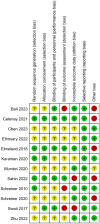Meta-analysis of the therapeutic effect of electrical stimulation combined with pelvic floor muscle exercise on female pelvic floor dysfunction
- PMID: 39039596
- PMCID: PMC11265018
- DOI: 10.1186/s40001-024-01979-1
Meta-analysis of the therapeutic effect of electrical stimulation combined with pelvic floor muscle exercise on female pelvic floor dysfunction
Abstract
Objectives: To systematically evaluate the therapeutic effect of electrical stimulation combined with pelvic floor muscle exercise on female pelvic floor dysfunction (PFD).
Methods: Preferred Reporting Items for Systematic Reviews and Meta-Analyses (PRISMA) was applied. A computer-based retrieval was performed in the databases of PubMed, Web of Science, Embase, and Cochrane Library from database establishment to September 15, 2023, to identify randomized controlled trials on electrical stimulation combined with pelvic floor muscle function exercise on female PFD. Literature screening, data extraction, and quality evaluation were performed independently by two researchers, and meta-analysis was performed using the statistical software Stata15.0.
Results: 1. In total, 12 randomized controlled trials were included, involving 721 female patients. The overall quality of methodologies employed in the included studies was relatively high. 2. Meta-analysis results showed that electrical stimulation combined with pelvic floor muscle exercise could effectively mitigate the severity of female PFD (SMD = -1.01, 95% CI - 1.78, - 0.25, P < 0.05). 3. This combination treatment demonstrated a significant positive effect on the improvement of pelvic floor muscle strength in female patients (P < 0.05); however, it had no significant effect on the improvement in quality of life (P > 0.05).
Conclusions: Compared with pelvic floor muscle exercise alone, electrical stimulation combined with pelvic floor muscle exercise could effectively mitigate the severity of female PFD. It had a notable positive impact on enhancing pelvic floor muscle strength in female patients, although it did not significantly improve quality of life. Future high-quality studies are warranted.
Keywords: Electrical stimulation; Meta-analysis; Pelvic floor dysfunction; Pelvic floor muscle exercise.
© 2024. The Author(s).
Conflict of interest statement
The authors declare that the research was conducted in the absence of any commercial or financial relationships that could be construed as a potential conflict of interest.
Figures









Similar articles
-
Effect of health education combined with biofeedback electrical stimulation on early pelvic floor function and psychology: A retrospective study.Medicine (Baltimore). 2024 Aug 23;103(34):e39321. doi: 10.1097/MD.0000000000039321. Medicine (Baltimore). 2024. PMID: 39183430 Free PMC article.
-
[Postpartum pelvic floor rehabilitation on prevention of female pelvic floor dysfunction: a multicenter prospective randomized controlled study].Zhonghua Fu Chan Ke Za Zhi. 2015 Jun;50(6):420-7. Zhonghua Fu Chan Ke Za Zhi. 2015. PMID: 26311549 Clinical Trial. Chinese.
-
Effect of increasing awareness of pelvic floor muscle function on pelvic floor dysfunction: a randomized controlled trial.Int Urogynecol J. 2015 Jun;26(6):837-44. doi: 10.1007/s00192-014-2599-z. Epub 2015 Jan 9. Int Urogynecol J. 2015. PMID: 25571864 Clinical Trial.
-
Effects of bariatric surgery on pelvic floor disorders in obese women: a meta-analysis.Arch Gynecol Obstet. 2017 Aug;296(2):181-189. doi: 10.1007/s00404-017-4415-8. Epub 2017 Jun 22. Arch Gynecol Obstet. 2017. PMID: 28643025 Review.
-
Pelvic floor and abdominal muscle cocontraction in women with and without pelvic floor dysfunction: a systematic review and meta-analysis.Clinics (Sao Paulo). 2019 Nov 25;74:e1319. doi: 10.6061/clinics/2019/e1319. eCollection 2019. Clinics (Sao Paulo). 2019. PMID: 31778432 Free PMC article.
Cited by
-
Female Sexual Function and Pelvic Floor Muscle Training: A Narrative Review.Cureus. 2025 Jun 11;17(6):e85751. doi: 10.7759/cureus.85751. eCollection 2025 Jun. Cureus. 2025. PMID: 40656351 Free PMC article. Review.
References
-
- Frawley H, Shelly B, Morin M, Bernard S, Bø K, Digesu G, Dickinson T, Goonewardene S, McClurg D, Rahnama’i M, et al. An International Continence Society (ICS) report on the terminology for pelvic floor muscle assessment. Neurourol Urodynam. 2021;40(5):1217–60. 10.1002/nau.24658.10.1002/nau.24658 - DOI - PubMed
-
- Bo K, Frawley H, Haylen B, Abramov Y, Almeida F, Berghmans B, Bortolini M, Dumoulin C, Gomes M, McClurg D, et al. An International Urogynecological Association (IUGA)/International Continence Society (ICS) joint report on the terminology for the conservative and nonpharmacological management of female pelvic floor dysfunction. Neurourol Urodynam. 2017;36(2):221–44. 10.1002/nau.23107.10.1002/nau.23107 - DOI - PubMed
Publication types
MeSH terms
LinkOut - more resources
Full Text Sources
Medical

